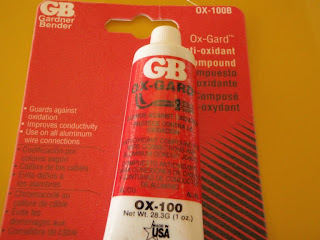
Found a tube of anti-corrosive paste for electrical connections in my local ACE Hardware store under the brand "Ox-Gard", Anti-Oxidant Compound by Gardner Bender. The stuff sells for $3 - $4 a tube and how it differs from dielectric grease is, in addition to its anti-corrosive properties, the paste is also conductive. Whereas dielectric grease works great for protecting brand new connections from the elements, on old cars where electrical connections have already degraded, anti-corrosive paste works way better in preventing further degradation and improves connectivity via its conductive properties ... from what I read anyways ... I'll let you know in 20 years if it's true. In the meantime, it can't hurt. All I know is, because it is conductive, care must be taken to wipe off any access to avoid current "jumping" to adjacent connections. Here's a list of other anti-corrosive products and their manufacturers from the K1TTT Amateur Radio Station website.
So, armed with a tube of Ox-Gard and some fresh fuses to get my multi-meter working again, I set out to restore all the electrical connections I could find under the hood to ensure corrosion free leads and proper grounding. To pick-up from where I left off with the main fuel injection relay, I was able to determine that input to the relay was indeed 12V, but output from the relay to the coil was still 10V indicating that the voltage drop was happening via the relay. Perhaps this is how its supposed to work by design? Or perhaps, the additional voltage is kicked in at ignition point? Who knows ... I have bigger problems to solve right now ... like the no-start situation. That's why I placed an order for the "Bosch Fuel Injection & Engine Management" book on a tip from blog reader George Downs of Bartlesville, OK (thanks George!). This book may be found in IPD's P1800 book section.
Oh yes, I'm also pretty sure at this point that the cause of the no-start is due to a faulty starter. I applied the following "stupid starter tricks" that I knew off and arrived at the conclusion that it's dead:
- My favorite - Banging on the starter solenoid with a hammer while attempting to start with the key. Sometimes the contacts in the solenoid get stuck and this low-tech approach may sometimes "free" them.
- Check that the starter is getting the full 12V via the lead directly from the battery - it is.
- Placing the transmission in gear and rocking the car back-and-forth before attempting to start. Sometimes the starter pinion gets stuck with the gears in the flywheel casing. This procedure should free it.
- The screwdriver trick - If the solenoid fails, the starter can be "jumped" by engaging the ignition to the "on" position and placing a screwdriver across the 2 leads on the starter. Screwdriver was too cumbersome, so I used 2 cables with aligator terminals instead - Lots of sparks, still no start!
Just for the heck of it, I also ran some tests found in this Volvo Fuel Injection Fault Tracing handbook downloaded from the Volvo 1800 Picture Gallery website, and found that my air temperature sensor was faulty. The resistance reading of a working air temperature sensor should be between 260 to 340 ohms - Mine was 400 ohms. Could this little thing be causing the no-start? If anything it should affect engine performance instead of preventing it from starting ... right? I'm not stating this as a fact as I'm obviously not the person to ask about these things. Merely thinking out loud or talking to myself ... which is not out of the ordinary. I really need to read that book!


No comments:
Post a Comment